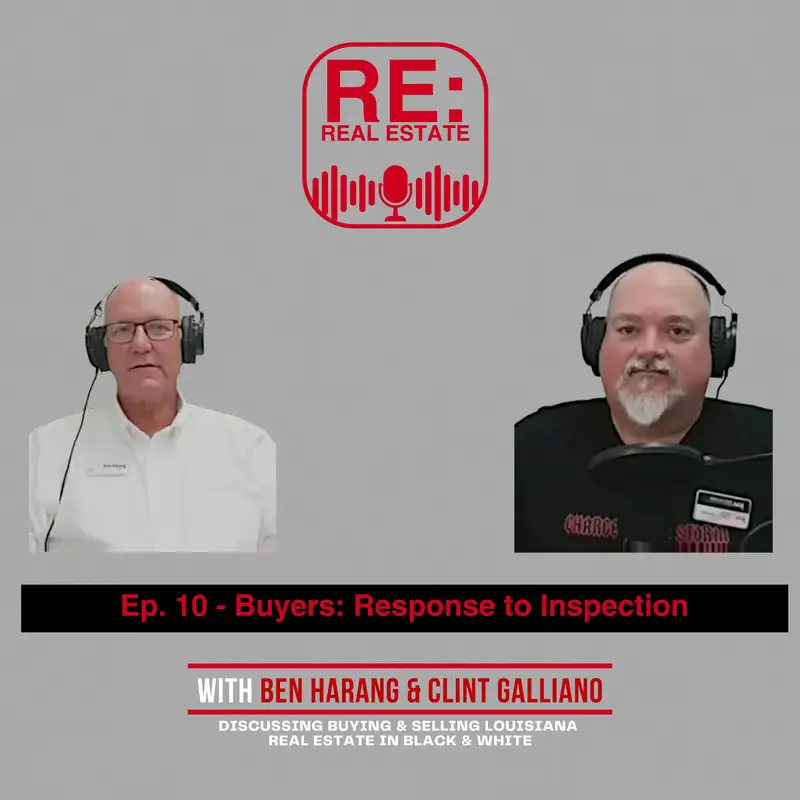Buyers: Response to Inspection
Clint C. Galliano (00:28)
How you doing, Ben?
Ben Harang (00:30)
Man, I'm doing terrific, man. How you doing today?
Clint C. Galliano (00:33)
I'm doing wonderful.
Ben Harang (00:36)
Glad to hear it. Wednesday afternoon, coming to you from Houma and Thibodaux Louisiana. We're going talk about inspections as a condition of the purchase agreement on residential property and just kind of the mechanics and how it's done. So I'm let Clint get started and we'll have some back and forth.
Clint C. Galliano (01:02)
All right, so we've talked about inspections already. That was a whole episode. So this is what comes next. We've done the inspection and we get the inspection report from the home inspector. At this point, we review as agents and with the buyers, we review the inspection and Ben and I have a slightly different approach
on the hows and the whys of how we treat the inspections. My approach is I look for things that may get flagged in the appraisal just to further to try and tighten up the timeline of getting to the closing. So if we can get things fixed that will.
keep something from being flagged in the appraisal, then that keeps us from having to wait to get it repaired and then bring the appraiser back out there to re-inspect and confirm that it's fixed before closing. Then that'll save us some time in the closing process. So that's the first things I look for is key things that may get flagged in an appraisal and then that's dependent on the loan type. Your government-backed loans have
things that they look for when in the appraisal that they want to be a certain way So we make sure that those things are not in the condition that will raise a flag. Main things are like chipped or peeling paint or exposed wood on the exterior of the property, appliances in the property that are working.
a permanent heat source that will heat the home above 50 degrees, 50 or 55, I think, depending on which type of loan you're using. So it can't be a window unit. It has to automatically heat the home when the temperature drops. The other things are like open junction boxes, exposed wiring in the attic.
Ben Harang (03:06)
Mm-hmm.
Clint C. Galliano (03:23)
things like that, those are also flags that the appraiser will call. And the ever-present TPR valve drain line, or should say the ever-not-present, because it seems like nobody puts those in or puts it in properly. So those tend to catch a flag. The other things I look for, go ahead, Ben.
Ben Harang (03:36)
Right. Right.
In
a TPR valve, just a clarification, is the pressure relief valve on the water heater. If the water heater, if it bursts, it's the pressure Well, not if it's going to burst. If the temperature of the pressure gets too high, there's a relief valve that releases the water and it has to be piped from the top down to the bottom into a drain source or outside.
Clint C. Galliano (03:54)
Yes, temperature and pressure relief.
Ben Harang (04:14)
And invariably they're just sitting there squirt you in the face if you happen to be standing there or sometimes they just put an elbow in pointed to the floor and which is still not good enough, but those are just some things to look for and We Clint and I do have a little different approach And we both do a good job representing our clients. I look at my
Opinion about the appraisals have changed if there's something obvious that I know the appraisal is gonna flag It ought to be addressed before the appraisal goes out I Used to beat myself over up trying to figure out what was gonna be flagged if it was gonna be flagged the obvious the peeling paint exposed wood Appliances in working order those things will get flagged and after that it's like
May or may not flag it. Let's let them come by and see it. And typically, if they do flag something, they're pretty good about going back out to do the re-inspection. So it doesn't cost much, if any time at all. So I used to get hung up on the appraisal. And now I make sure the major things are done and then let the appraiser go see what the appraiser sees. And we deal with the
the results. And if they do have to come back, they're typically only looking at what they flag. So,
They're not looking for anything else. They're not looking to find something they might have missed on the first round. So anyway, it's just a little different approach on how to handle the same process.
Clint C. Galliano (06:11)
And so, and I'm pretty much about in the same position or come from the same approach. I don't necessarily try and get, well, that might be an appraisal flag. It's like, all right, yeah, that's, we'll see if the appraiser flags it. You know, it's not necessarily an issue. But the other things we look for are things that are hazards.
So again, back to the TPR valve drain. That's a common thing. Another part for that is where it is connected to a drain, but it's nippled down to quarter-inch copper pipe that goes up and into the wall. And that's not correct either, because that's still providing back pressure.
A, by reducing it down to a quarter inch line from the three quarter inch exit that it has, and by putting it up so that it's actually putting hydrostatic pressure on it. So it's kind of defeating the purpose of that temperature pressure relief. actually raises it to a higher value. So those are things that technically that's hazard because that could cause that water tank to burst even though that's a really narrow window.
Ben Harang (07:04)
Mm-hmm.
Mm-mm.
Clint C. Galliano (07:33)
from a practical point of view, it's still outside of code. So that's one of the hazards. Things like if you have a gas furnace or like a gas dryer. Well, gas dryers not so much, but like a gas furnace or anything that runs a stack through the ceiling and through the roof, you have to have clearance.
Ben Harang (07:37)
Yeah.
Clint C. Galliano (07:59)
I think it's at least an inch of clearance all the way around so that the wood isn't touching that flue. If you have a water heater, that's right. If you have a water heater, you have to have an approved flue that goes up through the roof. can't just go up six inches and inside a water heater shed or under a roof or anything because the exhaust gases could build up and into your attic. Things like that.
Ben Harang (08:05)
Right, right, around a perimeter of the vent pipe.
Mm-hmm.
Clint C. Galliano (08:29)
So those are hazard type things. Things that are less critical are non-polarized electrical outlets, non-grounded outlets, GFCIs on an older home. We talked about the differences between new construction and older homes on another episode. And those aren't necessarily...
as critical a deal in the old homes because it wasn't required when it was originally installed. So those are some of the things that we kind of look out for in the inspection.
Ben Harang (09:01)
Yeah.
And you and I have talked before about adjusting the expectations. The inspection will go through the same components on a new construction or a 30 or 40 year old house. The result of those inspections will be different as well as the buyer's expectation of what they're actually going to be buying, whether they buy a new construction or a 30 or 40 year old house.
You know, I would like to use the inspection to renegotiate the price just to renegotiate the price on a property. If you should be making an offer on a property based on the apparent condition of the property and not come in and have a 40 year old house that does not have grounded receptacles. And so I want you to rewire the house discounted $25,000 because you don't have grounded receptacles. That's not realistic. Neither the expectation nor the
The expectation that will be done nor that's not what you buy So
Clint C. Galliano (10:12)
Yeah, I've run across that in the last couple of years at least three times where they say, well, we want the house rewired. And it's like, that's not happening. So no, not because of an inspection. So at that point we put together a list of things to be repaired, if anything.
Ben Harang (10:22)
Right. Houses don't get rewired.
Hmm.
Clint C. Galliano (10:36)
and send that as a buyer's response to inspection to the listing agent who shares that with the seller. And then the seller has the option to repair everything, repair some things, or repair nothing, or to provide cash in lieu of repairs at closing, or some combination thereof.
I recently closed a deal on one of my listings where the response was giving them $2,500 credit at closing on top of doing $500 worth of repairs that were likely going to get flagged.
Ben Harang (11:19)
Mm-hmm.
Clint C. Galliano (11:32)
on the appraisal and just because it needed to be done because it was some ridiculously dangerous electrical work. And that was perfectly fine. that was the response from the seller.
Ben Harang (11:33)
Yeah.
Yeah.
Mm-mm.
Clint C. Galliano (11:51)
to the buyer. The buyer asked for 21 items to be repaired, including rewiring some of the house and changing out all the outlets and putting grounded outlets in and stuff like that. And the sellers laughed and said, no, this is what we're going to do. And they said, OK. So it's the sellers respond with what they're willing to do. And then
Ben Harang (11:59)
Mm-hmm.
Clint C. Galliano (12:21)
The final phase of the response to inspection is the buyer's final response. And typically we'll have whatever your due diligence and inspection period is. And again, this is local to Louisiana. Whatever you negotiate in your purchase agreement, when you send your response to inspection, your inspection period ends. And then the sellers have three days or 72 hours to respond.
And then the buyers have three days or 72 hours to respond to that seller's response. And then that would be the buyer's chance to say, all right, the seller's response is unacceptable. We elect to not proceed towards active sale. And we're sending a cancellation to cancel the contract and well within their rights. And they get the good faith deposit back.
Ben Harang (12:58)
Yeah, just.
Clint C. Galliano (13:19)
or they say, okay, we accept it and we're moving towards active sale.
Ben Harang (13:26)
Yeah, what I was going to say is, when a buyer has their response to inspection, whether it's 21 items or one item or five items, if the seller agrees to it, the inspecting period is over. The seller does, makes the repairs and we move towards the closing. If the seller changes anything from what the buyer requests.
then it's going to be up to the buyer how they want to proceed. So I try to explain that to people that we're going to ask them for this. If they agree to it, then all this is behind us. They make the repairs and we move forward. If they don't agree to one thing of the 25 things, then it's up to the buyer how they're going to proceed based on the seller's response to inspections.
And like Clint said, once the buyer issues a response to the inspections, the inspection period is over. If you have a 14-day inspection period, excuse me, and you respond in seven days, you can't come back in 12 days and say, well, I forgot about this. I want to include this. Once you issue that response to inspection, the inspection period is over.
so it's it's the mechanics of it but the importance is the the timeline to live within the inspection period the 72 hour response from the buyer's response for the seller and the the buyers The the buyer's response to the seller's response to inspection is also 72 hours. So just the timelines are important don't get caught
because you're 12 hours late on an inspection and somebody can try to jam you up to say you're outside the inspection period. That's never a fun conversation to have. So, okay, Clint, what else?
Clint C. Galliano (15:30)
That's pretty much all I've got for inspections, our response to inspections. How about you, Ben?
Ben Harang (15:34)
Okay.
Well,
I think that's it. I think we, you and I have been talking about the episodes from the buyer side and then we'll probably flip the script and start talking about the process from a seller standpoint and see where it takes us. And Clint and I spent a little time yesterday together and
We were talking about doing some mobile stuff. And I also want to get some third parties on occasionally to talk about the different aspects, whether it's a lender, a title attorney, an appraiser, an inspector, just to hear it. We've been hearing from Clint and I talking about it. I think it's going to be good at some point to bring in a third party and kind of do a little deeper dive into each aspect of it.
So, but other than that, that's all I have for today, Clint.
Clint C. Galliano (16:30)
Well, another one in the can, Ben. We'll talk again next week.
Ben Harang (16:34)
Alright.
And we're not in Hollywood. All right, y'all have a good day. Thanks.
Clint C. Galliano (16:40)
Hahaha!
That's right, because we've got faces made for radio.
Ben Harang (16:47)
Yes, we do. Yes, we do make no mistake about that And even if we have faces made for radio like and subscribe and share the podcast or whatever platform you You watching it on just to give it a little broader reach
Clint C. Galliano (16:49)
you
Yep, and if you commented YouTube beers, we have no idea what that's in reference to, so let us know.
Ben Harang (17:07)
Let us know.
Yeah. All right. Y'all have a good one. Thanks.
Clint C. Galliano (17:14)
Thank you. Bye bye.
Creators and Guests



